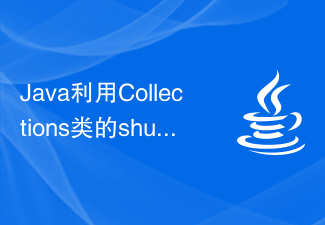Characteristics of Map collection:
1. It is a double-column collection. When assigning values, key and value must be assigned at the same time.
2. It is an unordered collection (storing and removing elements) The order may be inconsistent)
3. The key value cannot be repeated, but the value can be repeated
4. One key can only correspond to one vlaue
5. When defining a collection, the data type key and value can use the same data type. You can also use different data types
Characteristics of Map collection
java.util.Map
The first way to traverse a Map collection
The first way to traverse a Map collection: to find a value through a key
There is a method in the Map collection: keySet
Set
Steps to traverse the Map collection:
1. Define a Map collection and add elements to the collection
2. Call the Map collection The method keySet in the Map collection stores the keys in the Map collection into a Set collection
3. Traverse the Set collection and obtain all the keys in the Map collection
4. Use the get method of the Map collection to search through the obtained keys Value
1 public static void main(String[] args) { 2 //1.定义一个Map集合,往集合中添加元素 3 Map<string> map = new HashMap<string>(); 4 map.put("a", "1"); 5 map.put("b", "2"); 6 map.put("c", "3"); 7 map.put("d", "4"); 8 //2.调用Map集合中的方法keySet,把Map集合中的健存储到一个Set集合中 9 Set<string> set = map.keySet();10 //System.out.println(set.getClass());11 //3.遍历Set集合,获取Map集合所有的健12 //使用迭代器遍历13 Iterator<string> it = set.iterator();14 while(it.hasNext()){15 String key = it.next();16 //4.通过获取到的健,使用Map集合的方法get查找值17 String value = map.get(key);18 System.out.println(key+"..."+value);19 }20 System.out.println("----------------");21 //使用增强for遍历22 for(String key : set){23 //4.通过获取到的健,使用Map集合的方法get查找值24 String value = map.get(key);25 System.out.println(key+"..."+value);26 }27 System.out.println("----------------");28 //使用增强for遍历29 for(String key : map.keySet()){30 //4.通过获取到的健,使用Map集合的方法get查找值31 String value = map.get(key);32 System.out.println(key+"..."+value);33 }34 }</string></string></string></string>The second way of Map collection traversal
The second way of Map collection traversal: the way of traversing key-value pairs
Map There is a method in the collection: entrySet
Set
Traversal steps:
1. Define a Map collection and add elements to the collection
2. Call the entrySet method in the Map collection to add each mapping relationship in the Map collection ( Marriage certificate) into the Set collection
3. Traverse the Set collection and obtain each mapping relationship Entry
4. Use the methods getKey and getValue in Entry
1 public static void main(String[] args) { 2 //1.定义一个Map集合,往集合中添加元素 3 Map<string> map = new HashMap<string>(); 4 map.put("a", "1"); 5 map.put("b", "2"); 6 map.put("c", "3"); 7 map.put("d", "4"); 8 /* 9 * 2.调用Map集合中的方法entrySet,把Map集合中的每一个映射关系(结婚证)放入到Set集合中10 * 成员内部类的访问方式:外部类.内部类(Map.Entry)11 */12 Set<map.entry>> set = map.entrySet();13 //3.遍历Set集合,获取每一个映射关系Entry<k>14 //使用迭代器遍历Set集合15 Iterator<map.entry>> it = set.iterator();16 while(it.hasNext()){17 Map.Entry<string> entry = it.next();18 //4.使用Entry<k>中的方法getKey和getValue获取健和值19 String key = entry.getKey();20 String value = entry.getValue();21 System.out.println(key+"..."+value);22 }23 System.out.println("---------------------");24 //使用增强for遍历Set集合25 for(Map.Entry<string> entry:set){26 //4.使用Entry<k>中的方法getKey和getValue获取健和值27 String key = entry.getKey();28 String value = entry.getValue();29 System.out.println(key+"..."+value);30 }31 System.out.println("---------------------");32 //使用增强for遍历Set集合33 for(Map.Entry<string> entry:map.entrySet()){34 //4.使用Entry<k>中的方法getKey和getValue获取健和值35 String key = entry.getKey();36 String value = entry.getValue();37 System.out.println(key+"..."+value);38 }39 }</k></string></k></string></k></string></map.entry></k></map.entry></string></string>HashMap stores custom type key value
HashMap stores custom type key value
Custom type as the value of Map collection
Custom type as Map Keys of collections
Remember: when custom types override hashCode and equals
1. Use HashSet to store custom types
2. Use HashMap collections, and use custom types for keys
Hashtable
Map implementation class Hashtable
The underlying data structure is a hash table, the characteristics are the same as hashMap
Hashtable is a thread-safe collection and runs slowly
HashMap is a thread-unsafe collection and runs fast
The fate of Hashtable is the same as Vector. Starting from JDK1.2, it was replaced by the more advanced HashMap
HashMap allows the storage of null values. null key
hashtable is not allowed to store null values, null key
Hashtable His children, subclass Properties are still active in the development stage
LinkedHashMap collection features
java.util.LinkedHashMap extends HashMap implements Map
LinkedHashMap collection features:
1. Hash table + linked list: doubly linked list, which can guarantee the iteration order
2.Key cannot be repeated
Collections
java.util.Collections: Tool class for operating Collection collections
The methods in the tool class are all static methods and can be used directly through the class name
public static
public static void shuffle(List> list) // The storage location of collection elements is shuffled
Variable Parameter
New features that appeared after JDK1.5
Prerequisite for use: The data type of the method parameter is determined, but the number of parameters is uncertain
Using format:
Modifier return value type method name (data type...variable name){
}
...represents that the method can receive multiple parameters of the same data type
The bottom layer of variable parameters can be regarded as It is an array
Notes on variable parameters:
1. A method parameter can only use one variable parameter
2. If the method has multiple parameters , variable parameters must be written at the end of the parameter list
1 public static int add(int...arr){ 2 System.out.println(arr);//[I@104c575 3 System.out.println(arr.length); 4 int sum = 0; 5 //遍历可变参数-->遍历数组 6 for (int i : arr) { 7 sum +=i; 8 } 9 10 return sum;11 }static import
JDK1.5 new feature, static import
Reduce development time Code amount
Standard writing method, can only be used when importing a package
import static java.lang.System.out; At the end, it must be a static member
package cn.itcast.demo05;
import java.util.ArrayList;
import java.util.Collections;
import java.util.HashMap;
1 /* 2 * 带排序功能的斗地主案例: 3 * 1.准备牌 4 * 2.洗牌 5 * 3.发牌 6 * 4.排序 7 * 5.看牌 8 */ 9 public class DouDiZhu { 10 public static void main(String[] args) { 11 //1.准备牌 12 //创建存储序号和拍面值的Map集合 13 HashMap<integer> poker = new HashMap<integer>(); 14 //创建存储序号的List集合 15 ArrayList<integer> pokerNumber = new ArrayList<integer>(); 16 //创建序号的数组 17 String[] numbers = {"2","A","K","Q","J","10","9","8","7","6","5","4","3"}; 18 //创建花色数组 19 String[] colors = {"?","?","?","?"}; 20 //先把大王和小王存储到集合中 21 int index = 0; 22 poker.put(index, "大王"); 23 pokerNumber.add(index); 24 index++; 25 poker.put(index, "小王"); 26 pokerNumber.add(index); 27 index++; 28 29 //使用循环嵌套遍历两个数组,组成52张牌 30 for (String number : numbers) { 31 for (String color : colors) { 32 //把组合包的牌添加到集合中 33 poker.put(index, color+number); 34 pokerNumber.add(index); 35 index++; 36 } 37 } 38 //System.out.println(poker); 39 //System.out.println(pokerNumber); 40 41 //2.洗牌:洗的是牌的序号 42 //使用Collections中的方法shuffle 43 Collections.shuffle(pokerNumber); 44 //System.out.println(pokerNumber); 45 46 /* 47 * 3.发牌:发的也是牌的序号 48 * a.定义4个集合存储3个玩家和1个底牌 49 * b.遍历存储序号的List集合 50 * c.使用list集合的索引%进行判断进行发牌 51 * 注意:先判断底牌 52 */ 53 //a.定义4个集合存储3个玩家和1个底牌 54 ArrayList<integer> player01 = new ArrayList<integer>(); 55 ArrayList<integer> player02 = new ArrayList<integer>(); 56 ArrayList<integer> player03 = new ArrayList<integer>(); 57 ArrayList<integer> diPai = new ArrayList<integer>(); 58 59 //b.遍历存储序号的List集合 60 for(int i=0; i<pokernumber.size>=51){ 65 //存储底牌 66 diPai.add(number); 67 }else if(i%3==0){ 68 //给玩家1发牌 69 player01.add(number); 70 }else if(i%3==1){ 71 //给玩家2发牌 72 player02.add(number); 73 }else if(i%3==2){ 74 //给玩家3发牌 75 player03.add(number); 76 } 77 } 78 /*System.out.println(player01); 79 System.out.println(player02); 80 System.out.println(player03); 81 System.out.println(diPai);*/ 82 83 //4.排序 84 //使用Collections中的方法sort 85 Collections.sort(player01); 86 Collections.sort(player02); 87 Collections.sort(player03); 88 Collections.sort(diPai); 89 90 /*System.out.println(player01); 91 System.out.println(player02); 92 System.out.println(player03); 93 System.out.println(diPai);*/ 94 95 /* 96 * 5.看牌 97 */ 98 //调用看牌方法 99 lookPoker("刘德华",player01, poker);100 lookPoker("周润发",player02, poker);101 lookPoker("周星驰",player03, poker);102 lookPoker("底牌",diPai, poker);103 }104 105 /*106 * 定义一个看牌的方法107 * 返回值类型:void108 * 方法名:lookPoker109 * 参数列表:玩家和底牌的集合,存储排的Map集合110 * 使用查表法看牌:111 * 遍历List集合,获取Map集合key,使用key去Map集合中查找value112 */113 public static void lookPoker(String name,ArrayList<integer> list,HashMap<integer> map){114 System.out.print(name+":");115 //遍历List集合,获取Map集合key116 for (Integer key : list) {117 //使用key去Map集合中查找value118 String value = map.get(key);119 System.out.print(value+" ");120 }121 System.out.println();//换行122 }123 }</integer></integer></pokernumber.size></integer></integer></integer></integer></integer></integer></integer></integer></integer></integer></integer></integer>
The above is the detailed content of What is a Map collection? Characteristics of Map collections. For more information, please follow other related articles on the PHP Chinese website!
 PHP 5.4版本新功能:如何使用callable类型提示参数接受可调用的函数或方法Jul 29, 2023 pm 09:19 PM
PHP 5.4版本新功能:如何使用callable类型提示参数接受可调用的函数或方法Jul 29, 2023 pm 09:19 PMPHP5.4版本新功能:如何使用callable类型提示参数接受可调用的函数或方法引言:PHP5.4版本引入了一项非常便利的新功能-可以使用callable类型提示参数来接受可调用的函数或方法。这个新功能使得函数和方法可以直接指定相应的可调用参数,而无需进行额外的检查和转换。在本文中,我们将介绍callable类型提示的使用方法,并提供一些代码示例,
 Java使用Collections类的frequency()函数计算集合中指定元素出现的次数Jul 24, 2023 pm 09:48 PM
Java使用Collections类的frequency()函数计算集合中指定元素出现的次数Jul 24, 2023 pm 09:48 PMJava使用Collections类的frequency()函数计算集合中指定元素出现的次数在Java编程中,Collections类是一个包含了许多静态方法的实用类,用于对集合进行操作。其中之一是frequency()函数,用于计算集合中指定元素出现的次数。这个函数非常简单且易于使用,为Java开发人员提供了方便和灵活性。下面是一个示例代码,展示了如何使用
 产品参数是什么意思Jul 05, 2023 am 11:13 AM
产品参数是什么意思Jul 05, 2023 am 11:13 AM产品参数是指产品属性的意思。比如服装参数有品牌、材质、型号、大小、风格、面料、适应人群和颜色等;食品参数有品牌、重量、材质、卫生许可证号、适应人群和颜色等;家电参数有品牌、尺寸、颜色、产地、适应电压、信号、接口和功率等。
 Java利用Collections类的binarySearch()函数在有序集合中进行二分查找Jul 27, 2023 am 08:58 AM
Java利用Collections类的binarySearch()函数在有序集合中进行二分查找Jul 27, 2023 am 08:58 AMJava利用Collections类的binarySearch()函数在有序集合中进行二分查找二分查找是一种在有序集合中查找特定元素的高效算法。在Java中,我们可以利用Collections类的binarySearch()函数来实现二分查找。本文将介绍如何使用binarySearch()函数来在有序集合中进行查找,并提供具体的代码示例。二分查找算法的基本思
 PHP Warning: in_array() expects parameter的解决方法Jun 22, 2023 pm 11:52 PM
PHP Warning: in_array() expects parameter的解决方法Jun 22, 2023 pm 11:52 PM在开发过程中,我们可能会遇到这样一个错误提示:PHPWarning:in_array()expectsparameter。这个错误提示会在使用in_array()函数时出现,有可能是因为函数的参数传递不正确所导致的。以下我们来看看这个错误提示的解决方法。首先,需要明确in_array()函数的作用:检查一个值是否在数组中存在。该函数的原型为:in_a
 C++程序以给定值为参数,找到双曲正弦反函数的值Sep 17, 2023 am 10:49 AM
C++程序以给定值为参数,找到双曲正弦反函数的值Sep 17, 2023 am 10:49 AM双曲函数是使用双曲线而不是圆定义的,与普通三角函数相当。它从提供的弧度角返回双曲正弦函数中的比率参数。但要做相反的事,或者换句话说。如果我们想根据双曲正弦值计算角度,我们需要像双曲反正弦运算一样的反双曲三角运算。本课程将演示如何使用C++中的双曲反正弦(asinh)函数,使用双曲正弦值(以弧度为单位)计算角度。双曲反正弦运算遵循以下公式-$$\mathrm{sinh^{-1}x\:=\:In(x\:+\:\sqrt{x^2\:+\:1})},其中\:In\:是\:自然对数\:(log_e\:k)
 Java利用Collections类的shuffle()函数打乱集合中元素的顺序Jul 24, 2023 pm 10:25 PM
Java利用Collections类的shuffle()函数打乱集合中元素的顺序Jul 24, 2023 pm 10:25 PMJava利用Collections类的shuffle()函数打乱集合中元素的顺序在Java编程语言中,Collections类是一个工具类,提供了各种静态方法,用于操作集合。其中之一是shuffle()函数,它可以用来打乱集合中元素的顺序。本篇文章将演示如何使用该函数,并提供相应的代码示例。首先,我们需要导入java.util包中的Collections类,
 机器学习超参数调优总结(PySpark ML)Apr 08, 2023 pm 07:21 PM
机器学习超参数调优总结(PySpark ML)Apr 08, 2023 pm 07:21 PMML中的一个重要任务是模型选择,或者使用数据为给定任务找到最佳的模型或参数。这也称为调优。可以对单个的估计器(如LogisticRegression)进行调优,也可以对包括多种算法、特性化和其他步骤的整个pipeline进行调优。用户可以一次调优整个Pipeline,而不是分别调优 Pipeline 中的每个元素。ML中的一个重要任务是模型选择,或者使用数据为给定任务找到最佳的模型或参数。这也称为调优。可以对单个的Estimator(如LogisticRegression)进行调优,也


Hot AI Tools

Undresser.AI Undress
AI-powered app for creating realistic nude photos

AI Clothes Remover
Online AI tool for removing clothes from photos.

Undress AI Tool
Undress images for free

Clothoff.io
AI clothes remover

AI Hentai Generator
Generate AI Hentai for free.

Hot Article

Hot Tools

mPDF
mPDF is a PHP library that can generate PDF files from UTF-8 encoded HTML. The original author, Ian Back, wrote mPDF to output PDF files "on the fly" from his website and handle different languages. It is slower than original scripts like HTML2FPDF and produces larger files when using Unicode fonts, but supports CSS styles etc. and has a lot of enhancements. Supports almost all languages, including RTL (Arabic and Hebrew) and CJK (Chinese, Japanese and Korean). Supports nested block-level elements (such as P, DIV),

MantisBT
Mantis is an easy-to-deploy web-based defect tracking tool designed to aid in product defect tracking. It requires PHP, MySQL and a web server. Check out our demo and hosting services.

SAP NetWeaver Server Adapter for Eclipse
Integrate Eclipse with SAP NetWeaver application server.

Atom editor mac version download
The most popular open source editor

MinGW - Minimalist GNU for Windows
This project is in the process of being migrated to osdn.net/projects/mingw, you can continue to follow us there. MinGW: A native Windows port of the GNU Compiler Collection (GCC), freely distributable import libraries and header files for building native Windows applications; includes extensions to the MSVC runtime to support C99 functionality. All MinGW software can run on 64-bit Windows platforms.






